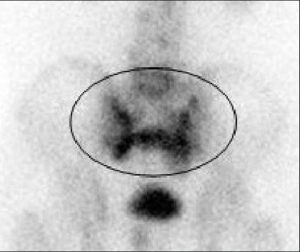The ‘H’ or ‘Honda’ Sign

At a recent patient discussion, we considered the importance of being specific in and around sacral pain.
Here are some thoughts regarding this:
Depending where you practice, the prevalence of sacral stress fractures may vary and insufficiency signs within the pelvic ring can be quite prevalent in certain elements of the population.
One very useful descriptive pattern that I have used is the ‘H’ sign which depicts the appearance of an ‘H’ or Honda sign representing increased radioisotope uptake in the sacral ale medial to the sacroiliac joints with a band connecting these vertical regions (Fujiii et al 2005).

This is very useful clinically, as with any diagnosis in the pelvic region being specific is a challenge but with certain criteria the chance of seeing an ‘H’ sign of signs of insufficiency can be higher than perhaps the lumbar region.
We are aware that the most common cases leading to sacral stress factors can be osteoporosis, long term corticosteroids therapy, post-menopausal, radiation therapy, Pagets Disease, hyperparathyroidism and RA (Yoder et al 2013).
Insufficiency fractures are due to poor density as compared to fatigue fractures that may occur in the athletic population (Ahovuo et al 2004). The challenge clinically is that these fractures get missed, however patients report minimal or no trauma, and are acutely tender over the sacral region.
Diagnosis is a challenge as X-Ray fails to note these, with MRI considered gold standard. When palpating the sacral region and finding any bony related pain, it is wise to think inflammatory changes, stress alterations, and fatigue rather than any sort of “dysfunctions” as this proposal would not sit sensibly with sacral and pelvic bony pain particularly without trauma.
When palpating, it is worth considering, the “H” sign as you provoke symptoms with pressure to help with the diagnosis.
References
Ahovuo, J.A., Kiuru, M.J. and Visuri, T., 2004. Fatigue stress fractures of the sacrum: diagnosis with MR imaging. European radiology, 14, pp.500-505.
Fujii, M., Abe, K., Hayashi, K., Kosuda, S., Yano, F., Watanabe, S., Katagiri, S., Ka, W.J. and Tominaga, S., 2005. Honda sign and variants in patients suspected of having a sacral insufficiency fracture. Clinical nuclear medicine, 30(3), pp.165-169.
Yoder, K., Bartsokas, J., Averell, K., McBride, E., Long, C. and Cook, C., 2015. Risk factors associated with sacral stress fractures: a systematic review. Journal of Manual & Manipulative Therapy, 23(2), pp.84-92.